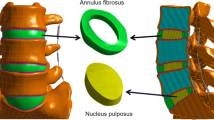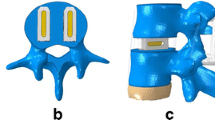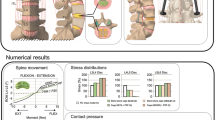Abstract
Introduction
A finite element model of the L4-L5 human segment was employed to carry out a parametric biomechanical investigation of lumbar interbody fusion with a novel “sandwich” cage having an inner stiff core and two softer layers in the areas close to the endplates, with and without posterior fixation.
Methods
Considered cage designs included: (a) cage in a homogeneous material with variable elastic modulus (19–2,000 MPa), (b) “sandwich” cage having an inner core (E = 2,000 MPa) and softer layers (E = 19 MPa) with variable thickness (1–2.5 mm). The latter cage was also considered in combination with posterior rods made with a material having variable elastic modulus (19–210,000 MPa). All the models were loaded with 500 N compression and moments of 7.5 Nm in flexion, extension, lateral bending and axial rotation.
Results
The homogeneous cage stabilized the segment in flexion, lateral bending and axial rotation; in extension there was a destabilization up to 60% and remarkable cage movement (1 mm). The “sandwich” cage limited this phenomenon (cage movement <0.6 mm), effectively stabilized the segment in the other directions and lowered the maximal contact pressure on the endplates, reducing the risk of subsidence. Posterior fixation reduced spinal flexibility and cage movement.
Conclusions
The soft layers of the “sandwich” cage had the potential to limit the risk of cage subsidence and to preserve a significant loading of the structure even in combination with flexible posterior instrumentation, which may have a beneficial effect in promoting bony fusion.




Similar content being viewed by others
References
Agazzi S, Reverdin A, May D (1999) Posterior lumbar interbody fusion with cages: an independent review of 71 cases. J Neurosurg 91(2 Suppl):186–192
Bagby GW (1988) Arthrodesis by the distraction-compression method using a stainless steel implant. Orthopedics 11(6):931–934
Blumenthal SL, Ohnmeiss DD, NASS (2003) Intervertebral cages for degenerative spinal diseases. Spine J 3(4):301–309
Chen SH, Tai CL, Lin CY, Hsieh PH, Chen WP (2008) Biomechanical comparison of a new stand-alone anterior lumbar interbody fusion cage with established fixation techniques: a three-dimensional finite element analysis. BMC Musculoskelet Disord 9:88
Cunningham BW, Polly DW Jr (2002) The use of interbody cage devices for spinal deformity: a biomechanical perspective. Clin Orthop Relat Res 394:73–83
Dietl RH, Krammer M, Kettler A, Wilke HJ, Claes L, Lumenta CB (2002) Pullout test with three lumbar interbody fusion cages. Spine 27(10):1029–1036
Eck KR, Bridwell KH, Ungacta FF, Lapp MA, Lenke LG, Riew KD (2000) Analysis of titanium mesh cages in adults with minimum two-year follow-up. Spine 25(18):2407–2415
Fantigrossi A, Galbusera F, Raimondi MT, Sassi M, Fornari M (2007) Biomechanical analysis of cages for posterior lumbar interbody fusion. Med Eng Phys 29(1):101–109
Freudenberger C, Lindley EM, Beard DW, Reckling WC, Williams A, Burger EL, Patel VV (2009) Posterior versus anterior lumbar interbody fusion with anterior tension band plating: retrospective analysis. Orthopedics 32(7):492
Galbusera F, Bellini CM, Anasetti F, Ciavarro C, Lovi A, Brayda-Bruno M (2011) Rigid and flexible spinal stabilization devices: A biomechanical comparison. Med Eng Phys 33(4):490–496
Goel VK, Panjabi MM, Patwardhan AG, Dooris AP, Serhan H, American Society for Testing and Materials (2006) Test protocols for evaluation of spinal implants. J Bone Joint Surg Am 88(Suppl 2):103–109
Gumbs AA, Bloom ND, Bitan FD, Hanan SH (2007) Open anterior approaches for lumbar spine procedures. Am J Surg 194(1):98–102
Hackenberg L, Halm H, Bullmann V, Vieth V, Schneider M, Liljenqvist U (2005) Transforaminal lumbar interbody fusion: a safe technique with satisfactory three to five year results. Eur Spine J 14(6):551–558
Harris BM, Hilibrand AS, Savas PE, Pellegrino A, Vaccaro AR, Siegler S, Albert TJ (2004) Transforaminal lumbar interbody fusion: the effect of various instrumentation techniques on the flexibility of the lumbar spine. Spine 29(4):E65–E70
Holzapfel GA, Schulze-Bauer CA, Feigl G, Regitnig P (2005) Single lamellar mechanics of the human lumbar anulus fibrosus. Biomech Model Mechanobiol 3(3):125–140
Jost B, Cripton PA, Lund T, Oxland TR, Lippuner K, Jaeger P, Nolte LP (1998) Compressive strength of interbody cages in the lumbar spine: the effect of cage shape, posterior instrumentation and bone density. Eur Spine J 7(2):132–141
Kettler A, Niemeyer T, Issler L, Merk U, Mahalingam M, Werner K, Claes L, Wilke HJ (2006) In vitro fixator rod loading after transforaminal compared to anterior lumbar interbody fusion. Clin Biomech (Bristol, Avon) 21(5):435–442
Kim Y, Kim TW (2010) Finite element analysis of the effects of pedicle screw fixation nut loosening on lumbar interbody fusion based on the elasto-plateau plasticity of bone characteristics. Spine (in press)
Kim Y, Vanderby R (2000) Finite element analysis of interbody cages in a human lumbar spine. Comput Methods Biomech Biomed Eng 3(4):257–272
Kim Y (2001) Prediction of mechanical behaviors at interfaces between bone and two interbody cages of lumbar spine segments. Spine 26(13):1437–1442
Korovessis P, Papazisis Z, Koureas G, Lambiris E (2004) Rigid, semirigid versus dynamic instrumentation for degenerative lumbar spinal stenosis: a correlative radiological and clinical analysis of short-term results. Spine 29(7):735–742
Krammer M, Dietl R, Lumenta CB, Kettler A, Wilke HJ, Büttner A, Claes L (2001) Resistance of the lumbar spine against axial compression forces after implantation of three different posterior lumbar interbody cages. Acta Neurochir (Wien) 143(12):1217–1222
Kurtz SM, Devine JN (2007) PEEK biomaterials in trauma, orthopedic, and spinal implants. Biomaterials 28(32):4845–4869 (review)
Kuslich SD, Ulstrom CL, Griffith SL, Ahern JW, Dowdle JD (1998) The Bagby and Kuslich method of lumbar interbody fusion. History, techniques, and 2-year follow-up results of a United States prospective, multicenter trial. Spine (Phila Pa 1976) 23(11):1267–1278 (discussion 1279)
Lund T, Oxland TR, Jost B, Cripton P, Grassmann S, Etter C, Nolte LP (1998) Interbody cage stabilisation in the lumbar spine: biomechanical evaluation of cage design, posterior instrumentation and bone density. J Bone Joint Surg Br 80(2):351–359
McAfee PC, Cunningham BW, Lee GA, Orbegoso CM, Haggerty CJ, Fedder IL, Griffith SL (1999) Revision strategies for salvaging or improving failed cylindrical cages. Spine 24(20):2147–2153
Oxland TR, Lund T (2000) Biomechanics of stand-alone cages and cages in combination with posterior fixation: a literature review. Eur Spine J 9(Suppl 1):S95–S101
Ray CD (1997) Threaded titanium cages for lumbar interbody fusions. Spine 22(6):667–679
Schmidt H, Heuer F, Drumm J, Klezl Z, Claes L, Wilke HJ (2007) Application of a calibration method provides more realistic results for a finite element model of a lumbar spinal segment. Clin Biomech (Bristol, Avon) 22(4):377–384
Schmidt H, Heuer F, Wilke HJ (2009) Which axial and bending stiffnesses of posterior implants are required to design a flexible lumbar stabilization system? J Biomech 42(1):48–54
Schmidt H, Galbusera F, Rohlmann A, Zander T, Wilke HJ (2010) Effect of multilevel lumbar disc arthroplasty on spine kinematics and facet joint loads in flexion and extension: a finite element analysis. Eur Spine J (in press)
Tsuang YH, Chiang YF, Hung CY, Wei HW, Huang CH, Cheng CK (2009) Comparison of cage application modality in posterior lumbar interbody fusion with posterior instrumentation–a finite element study. Med Eng Phys 31(5):565–570
Vadapalli S, Sairyo K, Goel VK, Robon M, Biyani A, Khandha A, Ebraheim NA (2006) Biomechanical rationale for using polyetheretherketone (PEEK) spacers for lumbar interbody fusion: a finite element study. Spine 31(26):E992–E998
Wehner T, Claes L, Niemeyer F, Nolte D, Simon U (2010) Influence of the fixation stability on the healing time: a numerical study of a patient-specific fracture healing process. Clin Biomech (Bristol, Avon) 25(6):606–612
Wilke HJ, Kettler A, Goetz C, Claes L (2000) Subsidence resulting from simulated postoperative neck movements: an in vitro investigation with a new cervical fusion cage. Spine 25(21):2762–2770
Wilke HJ, Heuer F, Schmidt H (2009) Prospective design delineation and subsequent in vitro evaluation of a new posterior dynamic stabilization system. Spine 34(3):255–261
Wilke HJ, Wenger K, Claes L (1998) Testing criteria for spinal implants: recommendations for the standardization of in vitro stability testing of spinal implants. Eur Spine J 7(2):148–154
Yan DL, Pei FX, Li J, Soo CL (2008) Comparative study of PLIF and TLIF treatment in adult degenerative spondylolisthesis. Eur Spine J 17(10):1311–1316
Zipfel GJ, Guiot BH, Fessler RG (2003) Bone grafting. Neurosurg Focus 14(2):e8
Acknowledgments
Funding by DSM Biomedical BV (Heerlen, The Netherlands) is gratefully acknowledged.
Conflict of interest
None of the authors has any potential conflict of interest.
Author information
Authors and Affiliations
Corresponding author
Rights and permissions
About this article
Cite this article
Galbusera, F., Schmidt, H. & Wilke, HJ. Lumbar interbody fusion: a parametric investigation of a novel cage design with and without posterior instrumentation. Eur Spine J 21, 455–462 (2012). https://doi.org/10.1007/s00586-011-2014-0
Received:
Accepted:
Published:
Issue Date:
DOI: https://doi.org/10.1007/s00586-011-2014-0




